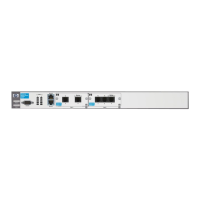3-5
Configuring Ethernet Interfaces
Ethernet Interfaces
Configuring an IP Address
To assign the Ethernet interface an IP address, you must be at the Ethernet
interface configuration mode context:
ProCurve(config-eth 0/1)#
You then have several options for assigning an IP address to an Ethernet
interface:
■ You can assign the Ethernet interface a static IP address.
■ You can configure the Ethernet interface as a Dynamic Host Configuration
Protocol (DHCP) client.
■ You can configure the Ethernet interface as an unnumbered interface.
Assigning a Static IP Address
To assign the Ethernet interface a static IP address, use the following com-
mand syntax:
Syntax: ip address <A.B.C.D> <subnet mask | /prefix length>
For example, you might enter:
ProCurve(config-eth 0/1)# ip address 192.168.1.1 255.255.255.0
Because the ProCurve Secure Router supports Classless Inter-Domain Rout-
ing (CIDR) notations, you could also enter:
ProCurve(config-eth 0/1)# ip address 192.168.1.1 /24
Note You must include a space between the IP address and the / symbol in front of
the prefix length.
Configuring the Ethernet Interface as a DHCP Client
If you are using DHCP to assign IP addresses to the clients on your network,
you may also want to have the DHCP server assign an IP address to the
Ethernet interface. To enable the DHCP client for the Ethernet interface, you
use one of the following commands:
Syntax: ip address dhcp {client-id [ethernet 0/<port> | HH:HH:HH:HH:HH:HH:HH] |
hostname <hostname>} [track <name>] [<administrative distance>]
Syntax: ip address dhcp [hostname <hostname> | no-default-route | no-domain-
name | no-nameservers] [track <name>] [<administrative distance>]

